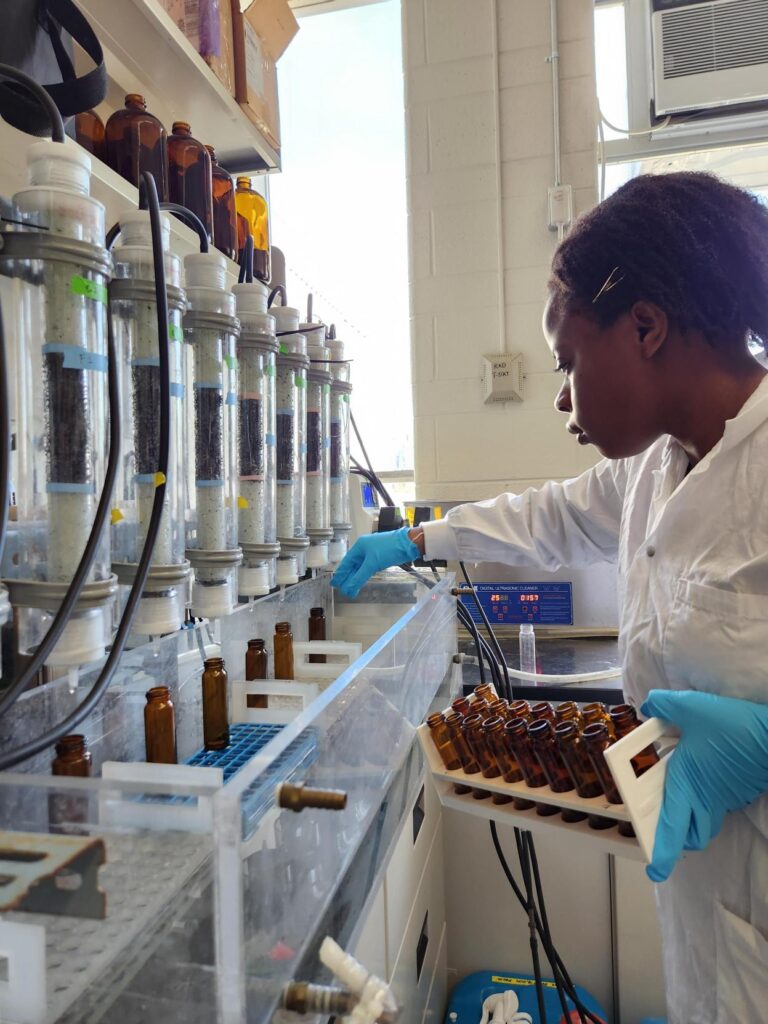Growing up in a small neighbourhood in Cameroon, Maeva Che was aware of challenges of accessing clean drinking water.

“Experiencing that exposure to water issues and challenges with sustainable access to safe drinking water ignited my interest in water treatment,” Che says.
Che’s drive to improve water quality challenges around the globe brought her to the University of Toronto’s Drinking Water Research Group (DWRG), where she is finding innovative solutions to solving local water issues.
A PhD candidate in the department of civil and mineral engineering, Che’s research focuses on removing unpleasant taste and odour compounds in Ontario’s drinking water by promoting the biodegradation of these compounds through granular activated carbon (GAC) filtration.
Under the supervision of Ronald Hofmann, a professor in the department of civil and mineral engineering and member of the DWRG, the project is supported by a five-year Natural Sciences and Engineering Research Council of Canada (NSERC) Alliance grant called, Advanced and Emerging Issues in Drinking Water Treatment.
A process used in water treatment plants, GAC filtration utilizes granular activated carbon, which is made from organic materials that are high in carbon, such as wood, coal, or coconut shells. These materials are heated in the absence of oxygen through a process known as pyrolysis and prompted chemically or physically to produce the activated carbon. The activation enhances the material’s adsorption properties, making it productive to remove contaminants from water.
While GAC filtration is an effective treatment process, its adsorptive capacity is limited. The adsorptive capacity of GAC is expected to become exhausted after about three years in service, so, drinking water treatment utilities must replace the GAC. Aside from the inconvenience, replacing GAC is costly.
Che is working on alternative ways to remove contaminants using GAC filtration, specifically through biodegradation. When GAC has been in service for a while, there is the growth of micro-organisms on the GAC, which can be useful for removing contaminants.
“Think of biodegradation as the useful bacteria on the GAC feeding on the contaminants in the water, thereby removing them.” Che explains.
“If the GAC has enough good bacteria that is biodegrading the compounds, the GAC may not need to be replaced when its adsorptive capacity becomes exhausted. This can extend the filter’s lifetime, resulting in cost benefits for treatment utilities.”

In other words, biodegradation can potentially enhance the performance of GAC filters.
Che and the DWRG will collaborate with water treatment plants to determine methods that can enhance the biodegradation of taste and odour compounds within their GAC filters.
Currently in its initial phase, the project is taking place alongside the Peterborough Utilities Group’s drinking water treatment plant, where Che is conducting pilot-scale filtration studies with support from the Peterborough Utilities Commission. They plan to extend this research to other partner treatment plants in the future.
Working with various water treatment plants across Ontario, Che will also assess the effectiveness of GAC filters in removing non-traditional taste and odour compounds which are not commonly monitored.
To achieve this, she’ll evaluate filter performance for two common taste and odour compounds – 2-methylisoborneal and geosmin – and eight additional non-traditional compounds that can cause taste and odour events. This involves collecting GAC and water samples from the plants and conducting lab-scale filtration tests, called minicolumn tests. This test, developed by the DWRG, allows to differentiate between adsorption and biodegradation in GAC filters.
Minicolumn tests provide crucial insights into the performance of the GAC filters in terms of the adsorption and biodegradation of contaminants. To distinguish between these mechanisms, researchers use parallel minicolumns. One minicolumn operates under conditions where the biological activity of micro-organisms is suppressed, which isolates the adsorption process. The second minicolumn operates without biological suppression, allowing both adsorption and biodegradation to occur.
“Many plants are unaware of their filters’ performance for other compounds, aside from the two common ones, that also contribute to taste and odour events in water. Our project, therefore, plays a crucial role in expanding the understanding of this,” Che says.
Some project partners include the Ajax Water Supply Plant and the Barrie Surface Water Treatment Plant.
Making a direct, practical impact
The DWRG is made of approximately 30 graduate students, post-doctoral fellows, research managers, and associates who collaborate with local, national and international industry and government organizations to address a wide range of projects related to municipal drinking water.
Che credits her experience as a master’s student with the research group as a major factor in her decision to pursue a PhD at the University of Toronto.
“During my master’s degree with the DWRG, I worked on projects that improved drinking water quality, gaining hands-on experience at treatment plants. Seeing the results of my research reinforced my decision to pursue my PhD here,” Che says.
Ultimately, Che hopes to make a significant impact in the field – and the DWRG provides opportunities to achieve this, with a supportive community of researchers and supervisors.
“My goal is to continue researching and developing sustainable solutions for drinking water treatment that benefit communities in need,” Che says.
By Tina Adamopoulos
This story University of Toronto Black Research Network